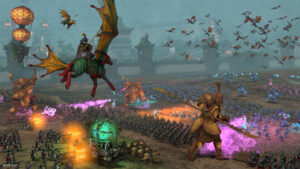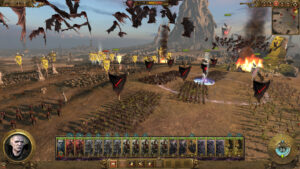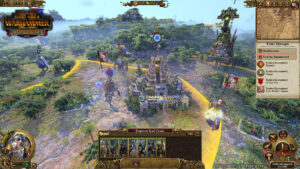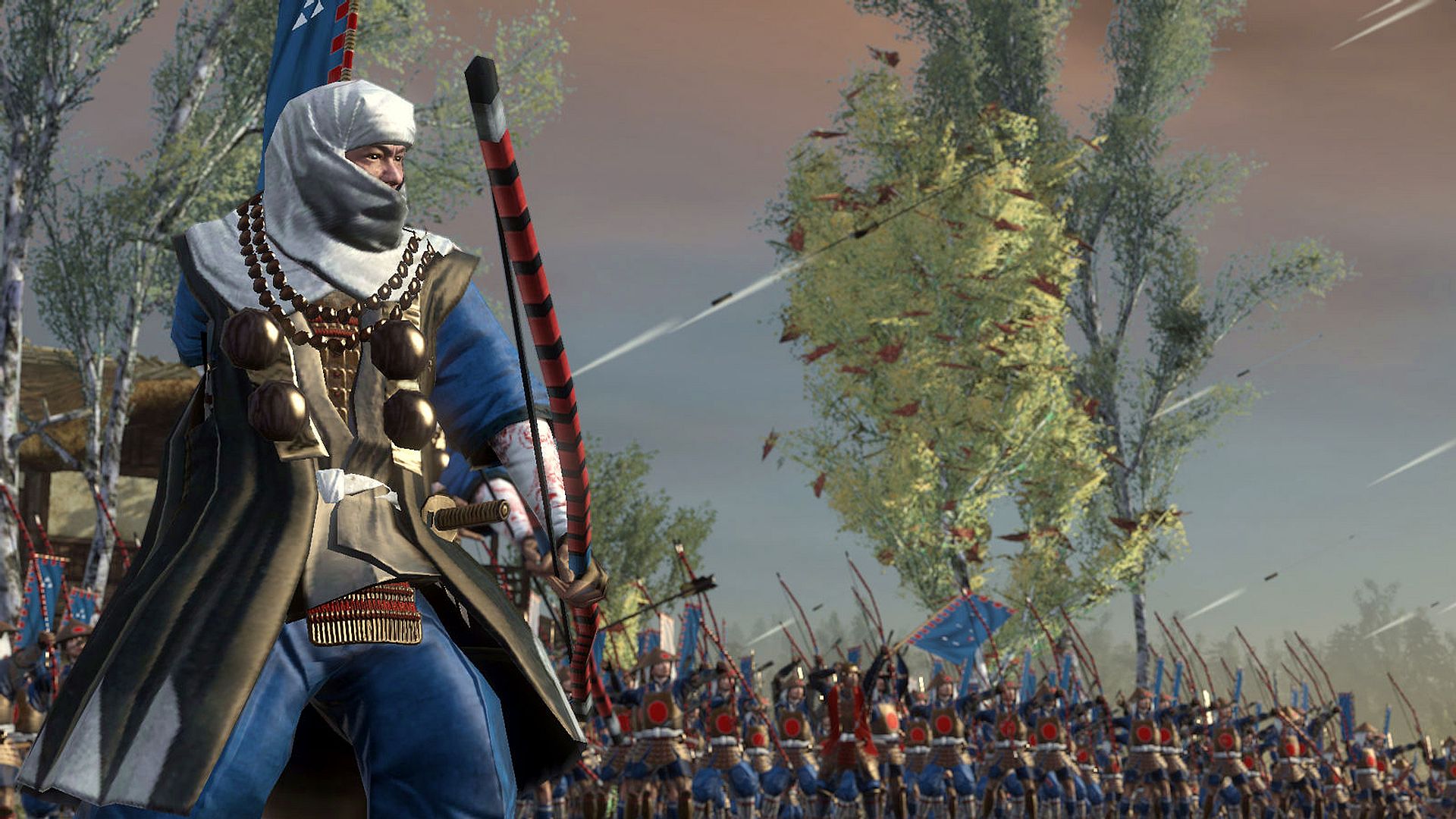The Total War series stands as a testament to the evolution of grand strategy gaming, tracing its roots back to the late 1990s with the release of “Shogun: Total War.” Developed by Creative Assembly, this groundbreaking title combined turn-based strategy with real-time tactical battles set in feudal Japan. Its innovative gameplay mechanics, including the management of provinces and armies on a vast campaign map, laid the foundation for what would become a beloved franchise.
Over the years, the series has expanded and evolved, exploring various historical periods and introducing new features with each installment. “Medieval: Total War” delved into the tumultuous medieval era, while “Rome: Total War” thrust players into the heart of ancient Rome’s power struggles. These games not only offered immersive historical settings but also provided deep strategic gameplay that challenged players to manage both military and political affairs.
The success of the Total War series can be attributed to its ability to balance complexity with accessibility. While the games offer deep strategic depth and historical authenticity, they also provide intuitive interfaces and helpful tutorials to guide newcomers. This balance has allowed the franchise to attract a diverse audience, ranging from history enthusiasts to hardcore strategy gamers, ensuring its longevity and relevance in the gaming industry.
Revolutionizing Gameplay

With each new installment, the Total War series has pushed the boundaries of what grand strategy gaming can achieve. “Empire: Total War” introduced naval battles and global trade routes, expanding the scope of gameplay to encompass colonial empires and maritime warfare. Meanwhile, “Napoleon: Total War” focused on the Napoleonic Wars, offering refined mechanics and enhanced graphics to immerse players in the epic conflicts of the early 19th century.
One of the series’ defining features is its seamless integration of turn-based strategy and real-time battles. Players must carefully plan their moves on the campaign map, managing resources, diplomacy, and military logistics, before engaging in tactical battles where the outcomes are determined by their strategic decisions and battlefield prowess. This dynamic gameplay loop keeps players engaged and invested in the unfolding narrative of their campaigns.
In addition to its single-player campaigns, the Total War series has also embraced multiplayer modes, allowing players to test their skills against friends and rivals from around the world. Whether cooperating in co-op campaigns or competing in head-to-head battles, the multiplayer experience adds another layer of depth and replayability to the games, fostering a vibrant community of dedicated players.
Pushing the Envelope
As the gaming industry continues to evolve, so too does the Total War series, with each new installment pushing the envelope in terms of innovation and ambition. “Total War: Warhammer” marked a departure from historical settings, introducing a fantasy world filled with legendary heroes, mythical creatures, and epic battles between the forces of good and evil. This bold move paid off, garnering critical acclaim and expanding the series’ fan base to include fans of the Warhammer tabletop game.
Building on the success of Total War: Warhammer, Creative Assembly released sequels that further expanded the scope and depth of the fantasy universe, introducing new factions, mechanics, and narrative arcs. The trilogy format allowed for continuous updates and improvements, ensuring that each installment felt fresh and exciting while maintaining the core gameplay that fans had come to love.
Looking to the future, the Total War series shows no signs of slowing down, with Creative Assembly teasing new projects and potential collaborations that promise to push the boundaries of grand strategy gaming even further. Whether delving into uncharted historical periods or exploring new realms of fantasy, one thing is certain: the Total War series will continue to captivate and inspire players for years to come.
Innovative Mechanics and Immersive Narratives
One of the hallmarks of the Total War series is its commitment to innovation, constantly introducing new mechanics and features to keep gameplay fresh and engaging. “Total War: Three Kingdoms” took players to ancient China, immersing them in the rich tapestry of the Three Kingdoms period. With its emphasis on character-driven storytelling and complex diplomatic interactions, the game introduced a new level of depth to the series, allowing players to forge alliances, betray rivals, and carve out their own dynasties.

The introduction of hero characters added a new dimension to gameplay, with each character possessing unique abilities and ambitions that could shape the course of the campaign. Whether leading armies into battle or vying for control of the imperial throne, these heroes became central figures in the narrative, driving players to explore the intricacies of Chinese history and legend.
Building on the success of Total War: Three Kingdoms, Creative Assembly continued to push the boundaries of storytelling and gameplay with “Total War Saga: Troy.” Inspired by Homer’s epic poem, the game transported players to the mythological world of ancient Greece, where they could command legendary heroes such as Achilles, Hector, and Odysseus in their quest for glory and conquest.
Technical Advancements and Visual Spectacles
In addition to its innovative gameplay mechanics, the Total War series has also set new standards for technical excellence and visual fidelity. Each new installment harnesses the latest technology to deliver stunning graphics, immersive soundscapes, and epic battles on an unprecedented scale. From the sprawling cities of ancient Rome to the windswept battlefields of medieval Europe, the attention to detail and historical accuracy are evident in every frame.
Recent entries in the series, such as “Total War: Warhammer III,” have raised the bar even higher, leveraging advanced rendering techniques and cutting-edge hardware to create jaw-dropping visuals that blur the line between reality and fantasy. Whether commanding hordes of demonic creatures or leading armies of noble knights, players are treated to a visual spectacle that rivals the biggest Hollywood blockbusters.
But it’s not just about eye candy; the technical advancements in the Total War series also extend to gameplay mechanics and artificial intelligence. Improved pathfinding algorithms ensure that units move and behave more realistically on the battlefield, while enhanced physics engines simulate the chaos and carnage of medieval warfare with unparalleled realism. These technical innovations not only enhance the player experience but also contribute to the overall immersion and authenticity of the games.
Community Engagement and Modding Support
Central to the success of the Total War series is its passionate and dedicated community of players, modders, and content creators. Creative Assembly has fostered a culture of collaboration and creativity, actively supporting modding tools and user-generated content that allow players to customize and expand their gaming experience. From simple tweaks and adjustments to full-blown total conversions, the modding community has produced an astonishing array of content that keeps the games fresh and exciting long after release.
But it’s not just about fan-made content; Creative Assembly also actively engages with its community through regular updates, patches, and downloadable content (DLC) that add new features, factions, and campaigns to the games. Whether addressing player feedback, fixing bugs, or introducing new content, the developers are committed to delivering a constantly evolving and improving experience for their fans.

In recent years, Creative Assembly has also embraced live streaming, social media, and esports to engage with its community on a more personal level. Regular streams, developer Q&As, and community events allow players to interact directly with the developers, providing feedback, sharing ideas, and forging connections with fellow fans. This open and transparent approach not only strengthens the bond between developers and players but also fosters a sense of ownership and investment in the future of the franchise.
Looking Ahead: The Future of Total War
As the gaming landscape continues to evolve, so too does the Total War series, with Creative Assembly constantly looking for new ways to innovate and expand the franchise. From exploring untapped historical periods to embracing new genres and storytelling techniques, the possibilities are endless for the future of Total War.
One exciting avenue for exploration is the realm of virtual reality (VR), which promises to immerse players in the world of Total War like never before. Imagine donning a VR headset and stepping onto the battlefield as a general, surveying the terrain, issuing orders to your troops, and witnessing the chaos of battle unfold in stunning detail all around you. While VR integration may still be in its infancy, the potential for Total War to leverage this emerging technology is immense.
Another area of interest is the growing trend of cross-platform gaming and cloud-based streaming services, which have the potential to break down barriers and bring Total War to a wider audience than ever before. By allowing players to seamlessly transition between PC, console, and mobile devices, Creative Assembly could tap into new markets and demographics, ensuring the longevity and relevance of the franchise for years to come.
Ultimately, the future of Total War is limited only by the imagination and ambition of its developers and the passion and creativity of its community. Whether charting new historical territories, exploring fantastical realms of myth and legend, or embracing cutting-edge technology and innovation, one thing is certain: the Total War series will continue to captivate and inspire players for generations to come.

